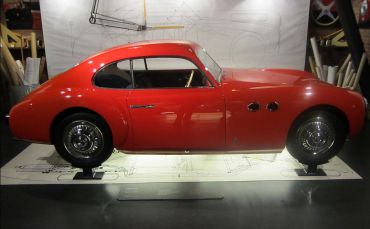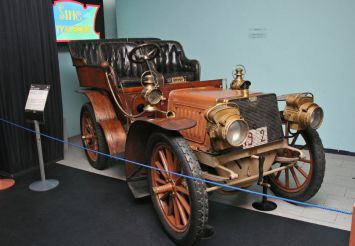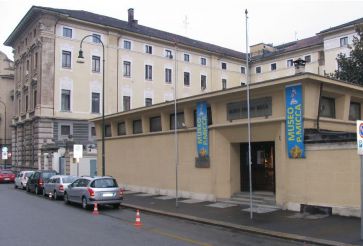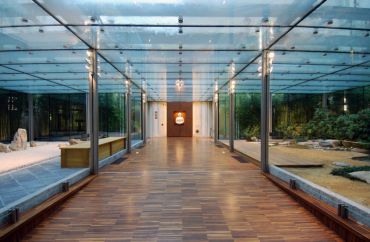National Automobile Museum, Turin

The National Automobile Museum (Museo dell'Automobile) is one of the most famous and visited places in Turin. It is also the largest museum in Europe and is among the best similarly themed museums in the entire world. Its rich collection of rare cars from different epochs even dating back to the dawn of motor industry was what contributed to it. In 2013 “The Times” magazine placed it on the 35th place in their list of 50 best museums in the world.
Museum’s history
The idea to create such museum appeared in the minds of two men who pioneered Italian automotive industry and co-founded FIAT – Cesare Gatti and Roberto Biscaretti di Ruffia. They suggested the idea in 1932 on the Turin Automobile Club members’ meeting. In 1933 Carlo Biscaretti di Ruffia, businessman's son, organized a temporary exhibition that consisted of 30 cars taken from the private family collection. With the support of government and Benito Mussolini himself, he began to gather everything he needed and choose a place for the museum. It was opened to the public in May 1939 inside the local stadium buildings. Having somehow survived the World War II the museum was moved to other buildings later. In 1995 a construction of another separate building started with Amedeo Albertini in charge. It was opened, however, after its founder passed away, on November 3rd, 1960, and was named after Carlo Biscaretti di Ruffia.
During the next years the collection was constantly growing, then in 1975 museum’s library gained influence. In the late 20th century exhibition space became obsolete, and in 2003 it was decided to perform a complete reconstruction here. The works began on April 10, 2007, under the guidance of architect Cino Zucchi and designer François Confino. After some significant interior changes, the museum was opened to the public once again on May 19, 2011.
Museum’s building
This was one of the few occasions when a separate building was constructed just for a museum. It was a typical example of modern architecture and was set on the hill at shores of the Po. The construction stands out with its impressive glass- and stone-covered façade that has an elongated curved shape. It creates this illusion as if it’s hanging in the air, but in reality, it is a reinforced concrete support system that keeps it in place. Side wings are connected to the central part thus creating a V-shape and forming an enclosed interior space. During reconstructions exterior remained the same; however, everything on the inside was significantly modified. A basement floor was added in as well, the courtyard soon came to be a vast covered hall. Exhibition spaces became state-of-the-art and received multimedia features.
Museum’s collection
There is a documentation center, bookstore, and café situated in the atrium. Further down the building, you’ll find what visitors mainly come here for. The exhibits are housed in 30 halls that take up 19000 square meters in total. The collection includes more than 200 rare and even unique cars and their prototypes such as steam machines dating back to 1769. Among all the variety there are also cars made by 80 manufacturers from 8 different countries. Besides that, you can find the detailed information presented as blueprints next to these cars. The whole exhibition is set on 3 floors each one has a different theme:
- Cars and design. This is the ground floor, and it focuses on car design. Here you can observe how vehicles evolved externally as the history progressed. You can also discover some important personalities that worked on automobile development.
- Man and the car. Second floor (8 halls) highlights the relationship between humans and machines, namely the process of automobile manufacturing. Visitors can find out about all the details involving said procedures and look into the car’s “soul”: engine, chassis, wheels and many other components that together create this holistic orchestra.
- The car and the XX century. The third floor (21 halls) houses the highest number of vehicles. This part is dedicated to the history of automotive industry – from the first self-propelled construction made by Leonardo da Vinci and up to the most advanced machines. Articulated narration leads the visitors through rows of chronologically placed exhibits. Such route helps you understand how cars influenced, caused and contributed to the most peculiar historical, economic, social events as well as those related to art back in the previous century.
It is somewhat hard to pick out the most impressive car out of this collection; however, the first Italian automobiles do have a special place here. These are Bernardi from 1896 and Fiat produced in 1899. One separate part of the building is dedicated to car racing. Formula One bolides and other automobile models that were used in racing competitions are here.
Italians didn’t forget about the ecological aspect: there are dirty elements of the car that ran on gas and clean parts of electro cars displayed in the hall. The basement houses “Garage” and “Restoration School.” “Garage” has around 50 cars which replace the ones in the central collection. In the “Restoration School” old cars are being restored so that one day they could be displayed in upper levels.
How to get
The museum is located on the south of Turin, in Lingotto district, on Corso Unità d'Italia, 40. Fruit Museum, Museum of Anatomy and the famous Castle of Valentino are 2 km away from here. Bus stops Fermata 2464 – Ventimiglia and Fermata 2258 – C.T.O can be found near the museum. You can catch buses 17, 17/, 34 and 74 there.
Opening hours: from 10:00 till 14:00 on Mondays, from 14:00 till 19:00 on Tuesdays, from 10:00 till 19:00 on Wednesdays and Thursdays, from 10:00 till 21:00 on Sundays and Fridays. The ticket office closes one hour before the closing time. Telephone: (+39) 011 677666.
Admission: full ticket costs 12 euros, children between the ages of 6 and 14, senior citizens over 65, students and groups of more than 15 people can purchase the reduced one which is 8 euros. Children under 6 are free of charge. The information is relevant for 2018.








